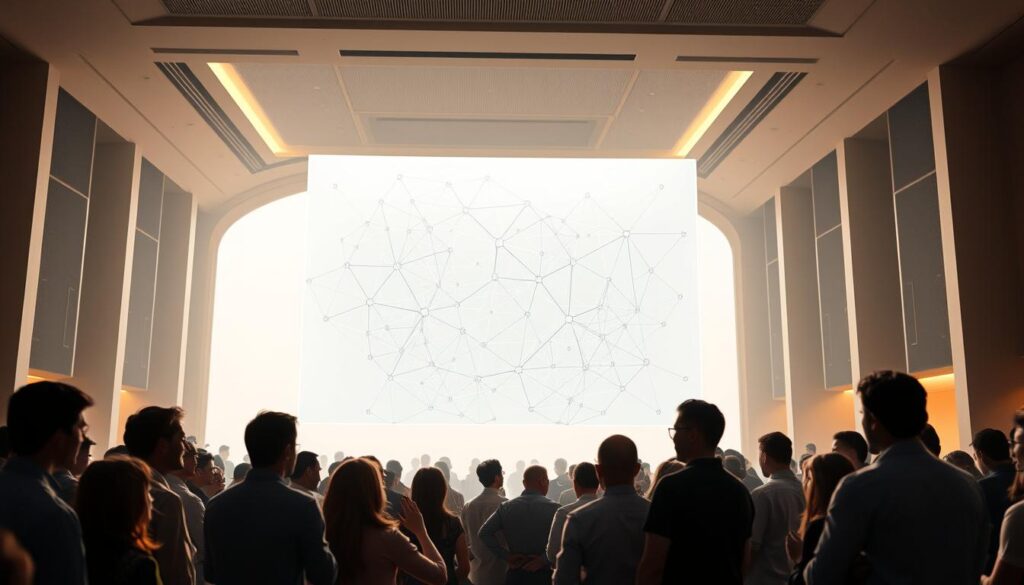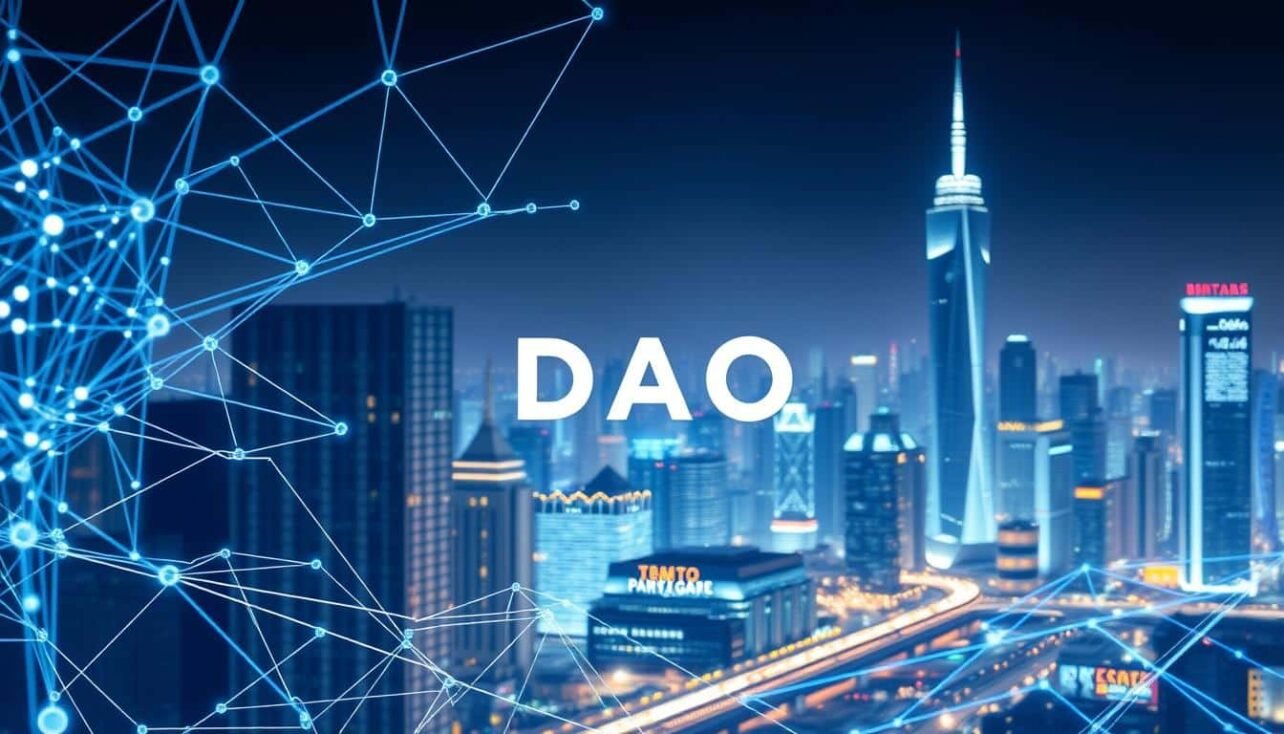Modern collaboration models face a paradox. Traditional systems demand trust in centralized authorities, while emerging technologies enable radical transparency. This tension birthed a new paradigm through Bitcoin’s 2009 debut – a self-governing network managed by code rather than executives.
The concept evolved dramatically in 2016. Ethereum developers launched a groundbreaking experiment: a member-owned entity funded through cryptocurrency. This venture collected $150 million before security flaws caused its collapse. Despite the setback, it proved decentralized systems could mobilize global resources.
Today’s advanced frameworks blend unique digital ownership with collective decision-making. Specialized assets now act as membership passes, voting instruments, and value-sharing mechanisms. They transform passive supporters into active stakeholders through programmable incentives.
These systems achieve what traditional corporations cannot. Participants collectively steer projects through transparent proposals and real-time feedback loops. Ownership becomes granular, allowing micro-contributions to accrue meaningful influence. The implications extend beyond finance into art, gaming, and social initiatives.
Key Takeaways
- Bitcoin pioneered decentralized governance through algorithmic consensus
- Early DAO experiments demonstrated both potential and security risks
- Modern systems combine unique digital assets with voting mechanisms
- Stakeholders gain proportional influence through token ownership
- New models enable global participation in project direction
- Transparent governance replaces traditional hierarchical structures
Understanding Decentralized Autonomous Organizations (DAOs)
The digital revolution has rewritten the rules of collective action. Unlike traditional entities, these groups operate through shared ownership and automated protocols. Members collaborate globally without CEOs or boardrooms, guided by code rather than corporate policies.
Historical Evolution and Key Milestones
Bitcoin’s blockchain first demonstrated decentralized coordination in 2009. The concept matured in 2016 when developers launched a member-driven venture on Ethereum. This early experiment raised $150 million before security flaws caused its collapse. Despite setbacks, it proved global communities could pool resources effectively.
By August 2021, DAO treasuries surged 3072% to $9.2 billion. This growth reflects improved frameworks addressing past vulnerabilities. Modern systems now prioritize security while maintaining open participation.
How DAOs Operate Through Smart Contracts
These organizations rely on self-executing agreements called smart contracts. When predefined conditions meet, actions trigger automatically – from fund releases to voting outcomes. This eliminates intermediaries while ensuring transparent transactions.
Three core functions define DAO mechanics:
- Automated treasury management
- Token-based voting systems
- Immutable activity records
| Aspect | Traditional Org | DAO |
|---|---|---|
| Governance | Centralized | Token-weighted |
| Decision Speed | Weeks/Months | Real-time |
| Transparency | Limited | Full visibility |
| Asset Growth (2020-2021) | 12% Average | 3072% Increase |
For those exploring this model, our comprehensive guide details technical foundations. Meanwhile, operational mechanics reveal how code enforces community-driven rules.
The Emergence of NFT Utility Tokens in Modern DAOs
Digital ownership models are undergoing a radical shift. What began as pixelated art trading now shapes how communities govern shared initiatives. Unique blockchain assets now serve as keys to decision-making power in member-driven networks.
Leading platforms let users stake these assets for rewards or exclusive access. Unlike interchangeable coins, each unit reflects specific contributions or milestones. This distinctiveness allows networks to recognize individual impact within collaborative ecosystems.
From Digital Collectibles to Governance Tools
Forward-thinking groups issue specialized assets that unlock tiered privileges. Owners might vote on fund allocation or propose protocol upgrades, with influence scaling based on participation history. One music collective grants proposal rights only to assets held for 90+ days.
Three critical developments enable this evolution:
- Customizable smart contracts that encode voting parameters
- Platforms supporting asset-gated communities
- Transparent contribution tracking systems
These advancements create dynamic participation frameworks. Members earn governance power through consistent engagement rather than mere capital ownership. The model fosters deeper investment in collective success while maintaining open access.
Exploring NFT Utility Tokens and their role in decentralized autonomous organizations

Blockchain-powered communities are redefining collaborative ownership. Specialized groups now use unique digital items to grant tiered access and voting power. For example, Meta Cartel DAO allows members to fund Ethereum startups, while Krause House lets basketball fans collectively own NBA memorabilia.
These systems transform how value creation works. Collector groups pool resources to acquire rare digital art, splitting ownership through fractional stakes. One platform reported 47% growth in shared asset portfolios last year. This approach lowers entry barriers for new participants.
| DAO Type | Focus Area | Membership Model |
|---|---|---|
| Collector | Digital Art | Fractional ownership |
| Investment | Startups | Proposal-based funding |
| Community | Sports | Shared memorabilia access |
Three key features enable these models:
- Customizable access rules encoded in smart contracts
- Transparent contribution tracking systems
- Automated reward distribution mechanisms
Active participants earn governance rights through consistent engagement. Some platforms weight voting power based on asset-holding duration. This design encourages long-term commitment rather than speculative trading.
These frameworks create alignment between individual goals and collective success. As community members gain influence through provable contributions, traditional hierarchical structures become obsolete. The next section explores how these principles scale across global networks.
Governance and Community Impact in the Web3 Ecosystem
Transparent decision-making becomes reality in blockchain-powered communities. Members collectively shape policies through innovative voting systems, replacing top-down authority with code-enforced rules. This shift creates accountability while maintaining flexibility for evolving community needs.

Voting Mechanisms and Decision-Making Processes
Modern platforms use diverse methods to balance influence. Quadratic voting reduces whale dominance by valuing participation breadth over token quantity. Reputation systems track contributions, granting experienced members weighted votes.
| Voting Model | Key Feature | Adoption Rate |
|---|---|---|
| Token-Weighted | 1 token = 1 vote | 62% of DAOs |
| Quadratic | Diminishing returns | 18% |
| Reputation-Based | Activity metrics | 15% |
| Role-Specific | Expertise tiers | 5% |
A music collective demonstrates this evolution. Their system requires 90-day asset ownership for proposal rights, blending commitment with governance access. Such models prevent flash decisions while rewarding loyal contributors.
Transparency Through Open-Source Smart Contracts
Every transaction and decision remains visible on-chain. Publicly auditable smart contracts let members verify fund flows in real-time. This openness builds trust but raises privacy questions for sensitive community matters.
Platforms now develop tools for non-technical users. Simplified interfaces translate complex code into visual workflows, making decentralized governance frameworks accessible to all participants. Balance emerges between transparency and practical usability.
Collective Ownership and Investment Strategies Within DAOs
Pooling resources allows communities to own premium digital assets previously reserved for elite investors. This approach transforms exclusive markets into collaborative ventures where members share risks and rewards proportionally.

Breaking Barriers Through Shared Access
PleasrDAO demonstrated this model by acquiring Edward Snowden’s historic “Stay Free” piece for $5.4 million. Over 70 contributors split costs while retaining shared control through blockchain records. Such deals make culturally significant works accessible beyond individual budgets.
Three core benefits drive this movement:
- Reduced entry costs for blue-chip projects
- Automatic profit distribution via smart contracts
- Community-driven curation enhancing asset value
| Ownership Model | Minimum Entry | Liquidity Options |
|---|---|---|
| Individual | $200k+ | Private sales |
| Collective | $500 | Token exchanges |
APE DAO’s strategy highlights scalability. They divided 49 rare primate assets into 1 million tokens, selling out in 96 hours. This created instant liquidity while preserving the original collection’s integrity.
Risks include governance disputes over asset management. Some platforms address this through time-locked voting rights. Members earn decision power by holding tokens longer, aligning interests with long-term success.
These models reshape investment strategies in crypto markets. As more groups adopt shared ownership frameworks, traditional financial hierarchies face irrelevance. The next evolution combines these principles with advanced reward mechanisms.
The Role of Smart Contracts and Tokenomics in DAO Functionality
Digital communities now operate through code-enforced frameworks that eliminate manual oversight. Self-executing agreements form the backbone of these systems, managing everything from fund allocation to membership rights. Their unchangeable nature ensures participants follow predefined rules without relying on third parties.
Immutable Codes and Automated Rules
Smart contracts act as robotic administrators. Once deployed, they process transactions and enforce policies 24/7. A DAO’s treasury remains locked until members reach consensus through coded voting thresholds. This setup prevents unilateral changes while maintaining full audit trails.
| Process | Traditional Method | DAO Approach |
|---|---|---|
| Treasury Management | Bank approvals | Automated fund releases |
| Voting | Paper ballots | Token-weighted polls |
| Reward Distribution | Manual payroll | Instant crypto payments |
Economic Incentives and Community Rewards
Tokenomics aligns individual goals with collective success. Members earn governance power through active participation, not just capital investment. Staking mechanisms reward long-term holders, while contribution trackers recognize valuable input.
Leading platforms use tiered systems:
- Basic access through token ownership
- Enhanced voting rights for stakers
- Exclusive perks for top contributors
These models transform passive holders into engaged stakeholders. Automated protocols ensure fair reward distribution, fostering sustainable growth across decentralized networks.
Integrating NFT Utility Tokens for Enhanced Project Governance
Communities are rewriting rulebooks using blockchain-based tools. Three pioneering projects demonstrate how digital assets reshape decision-making:
Case Studies in Action
Gutter Cat Gang DAO grants voting rights to asset holders for event planning and fund allocation. Their platform transforms collectors into active stewards, pushing beyond typical fan clubs.
MeebitsDAO shows community initiative at scale. Members pooled resources to buy virtual land across metaverses, building ecosystems for their avatars without central oversight.
In gaming, Axie Infinity plans to shift control to players. Their roadmap includes letting members vote on character mechanics and economic policies – a radical departure from studio-controlled development.
These models prove diverse approaches work:
- Founder-guided systems with gradual decentralization
- Grassroots collectives pursuing shared goals
- Hybrid structures balancing innovation and input
While challenges like slow consensus exist, the shift toward community-led governance marks irreversible progress. Digital ownership now means having skin in the game.


No comments yet